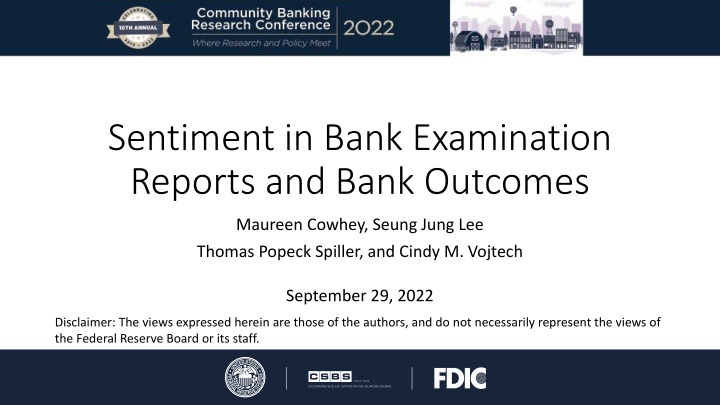
Sentiment in Bank Examination Reports: Enhancing Bank Supervision
This study investigates the role of sentiment in bank examination reports to improve bank supervision for small and medium-sized state-member banks in the United States. By analyzing detailed information beyond CAMELS ratings, the research focuses on how sentiment conveys essential insights into future bank outcomes. The comprehensive analysis explores the effectiveness of supervision in maintaining banking system safety and soundness, providing valuable implications for regulatory practices.
Download Presentation

Please find below an Image/Link to download the presentation.
The content on the website is provided AS IS for your information and personal use only. It may not be sold, licensed, or shared on other websites without obtaining consent from the author. If you encounter any issues during the download, it is possible that the publisher has removed the file from their server.
You are allowed to download the files provided on this website for personal or commercial use, subject to the condition that they are used lawfully. All files are the property of their respective owners.
The content on the website is provided AS IS for your information and personal use only. It may not be sold, licensed, or shared on other websites without obtaining consent from the author.
E N D
Presentation Transcript
NONCONFIDENTIAL // EXTERNAL Sentiment in Bank Examination Reports and Bank Outcomes Maureen Cowhey, Seung Jung Lee Thomas Popeck Spiller, and Cindy M. Vojtech September 29, 2022 Disclaimer: The views expressed herein are those of the authors, and do not necessarily represent the views of the Federal Reserve Board or its staff.
NONCONFIDENTIAL // EXTERNAL What Is the Extra Information in Bank Exams? This paper investigates the effectiveness of supervision in maintaining the safety and soundness of the banking system in the United States Focused on small and medium-sized state-member banks (SMBs) We look beyond the CAMELS rating to gauge the usefulness of more detailed information in the surveillance process We study how sentiment in examination reports conveys important information on future bank outcomes Cowhey, Lee, Spiller, and Vojtech (2022) Sentiment in Bank Examination Reports and Bank Outcomes 2
NONCONFIDENTIAL // EXTERNAL Comprehensive Full-Scope Bank Exam Process Cowhey, Lee, Spiller, and Vojtech (2022) Sentiment in Bank Examination Reports and Bank Outcomes 3
NONCONFIDENTIAL // EXTERNAL CAMELS Ratings Comprehensive score: Not additive of other scores Capital Adequacy: Ability of the bank to absorb losses Asset Quality: Known and likelihood of losses the bank might face Management: Quality of the management team, compliance function, audit function, and business strategy Earnings: Ability of the bank to provide returns on their activities Liquidity: Ability of the bank to absorb short term funding difficulties Sensitivity to Market Risk (we ignore in our analysis) Cowhey, Lee, Spiller, and Vojtech (2022) Sentiment in Bank Examination Reports and Bank Outcomes 4
NONCONFIDENTIAL // EXTERNAL Strong/Weak Banks by CAMELS Component Cowhey, Lee, Spiller, and Vojtech (2022) Sentiment in Bank Examination Reports and Bank Outcomes 5
NONCONFIDENTIAL // EXTERNAL Chatterplot for Capital Sections Cowhey, Lee, Spiller, and Vojtech (2022) Sentiment in Bank Examination Reports and Bank Outcomes 6
NONCONFIDENTIAL // EXTERNAL Evaluating Sentiment Scores where s is the section of the exam, m is the sentiment score method, and lis the sentiment score lexicon, with constant term and coefficient and an error term LM Polar and LM Valence Shifter have generally the highest explanatory power Cowhey, Lee, Spiller, and Vojtech (2022) Sentiment in Bank Examination Reports and Bank Outcomes 7
NONCONFIDENTIAL // EXTERNAL Sentiment Distribution by CAMELS Score Cowhey, Lee, Spiller, and Vojtech (2022) Sentiment in Bank Examination Reports and Bank Outcomes 8
NONCONFIDENTIAL // EXTERNAL Measuring Outcomes for bank i, in period t, for bank exam component c, and is a time fixed effect, respectively Cowhey, Lee, Spiller, and Vojtech (2022) Sentiment in Bank Examination Reports and Bank Outcomes 9
NONCONFIDENTIAL // EXTERNAL Summary Findings Relationship with outcomes? Section Overall? Weak banks Strong banks Outcome Composite supervisory actions Capital capital ratio Asset quality problem loans Management supervisory actions Earnings profitability Liquidity cash and securities Cowhey, Lee, Spiller, and Vojtech (2022) Sentiment in Bank Examination Reports and Bank Outcomes 10
NONCONFIDENTIAL // EXTERNAL Other Results When comparing the GFC and post-GFC periods, the results for asset quality and earnings are driven by the GFC period When running similar analysis at longer horizons (2 years forward), results are still statistically significant (though magnitudes are smaller) The results across components are generally the same when comparing the smallest banks to the rest of the sample Cowhey, Lee, Spiller, and Vojtech (2022) Sentiment in Bank Examination Reports and Bank Outcomes 11
NONCONFIDENTIAL // EXTERNAL Conclusion We investigate to see if supervisory information helps predict future bank outcomes After controlling for bank ratings, the answer seems to be YES! Bank supervisors play a meaningful role in the surveillance of the banking system by creating and sharing information that is embedded in reports through the bank examination process Supervisors seem to focus on different aspects of safety and soundness in different circumstances Cowhey, Lee, Spiller, and Vojtech (2022) Sentiment in Bank Examination Reports and Bank Outcomes 12
NONCONFIDENTIAL // EXTERNAL Appendix Cowhey, Lee, Spiller, and Vojtech (2022) Sentiment in Bank Examination Reports and Bank Outcomes 13
NONCONFIDENTIAL // EXTERNAL Extracting Sentiment from Bank Exam Reports Consider different dictionaries: LM (Loughran and McDonald, 2011) FS (Correa, Garud, Londono, and Mislang, 2017) QDAP (Hu and Liu, 2004) Consider different methodologies: Polar = (# of Positive Words # of Negative Words)/(# of Positive + Negative Words) TF-IDF = Term Frequency - Inverse Document Frequency Valance shifter = include contextual information that influence the positive/negative state of a word Cowhey, Lee, Spiller, and Vojtech (2022) Sentiment in Bank Examination Reports and Bank Outcomes 14

